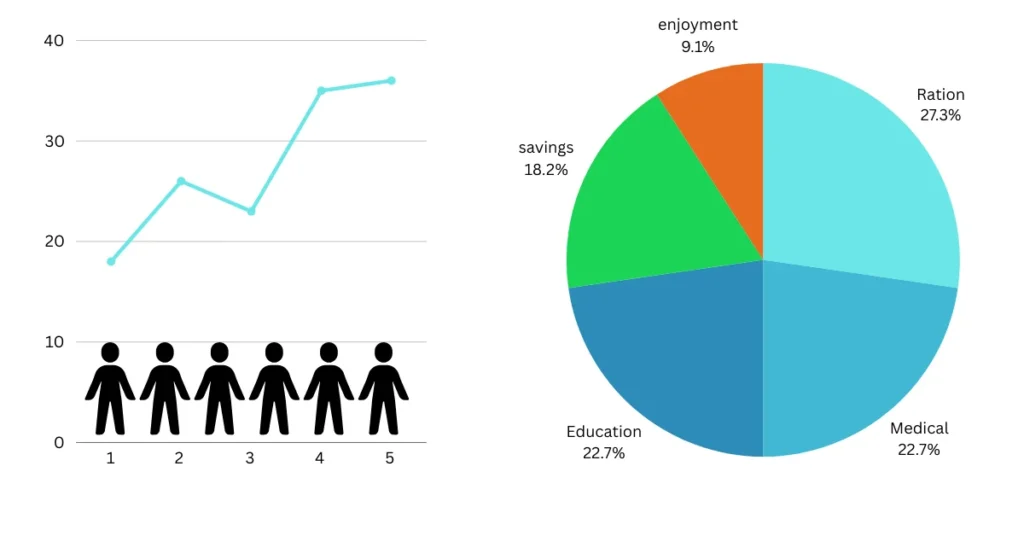
Introduction
As more people are marrying later in life, a new type of blended family is becoming more common. These families blend adult children into the new marriage along with their parents. This differs from traditional blended families formed after divorce involving younger kids. Late-life remarriages present both challenges and chances to get closer as a family. Today we will learn how to Navigating Blended Families with Adult Children
I know about the difficulties because I recently married my husband who had two daughters in their early 20s living with us. We hoped everyone would feel like one happy household. But during the adjustment, it was clear just how intricate these ties can be. My stepdaughters weren’t used to sharing their dad or childhood home with a stepmom. As their dad’s new wife, I had to get acquainted with these adult women and find ways we could all support each other. It took work from each of us to feel at ease in our new roles and develop understanding between stepsisters and stepmother.
Challenges of Blended Families with Adult Children
One hurdle we faced was integrating into the existing sibling dynamic between my stepdaughters. They had a tight bond formed over the years, so finding my place took sensitivity. Their different priorities also clashed occasionally with mine and my husband’s as empty nesters. Naturally, shifts in the family structure elicited some resistance too. Bringing separate financial situations together required open discussions about inheritance and sharing household expenses. Perhaps most nuanced was deciding how much independence to give while still fostering a sense of family under one roof.
When families blend later in life with adult children, it can be not easy to integrate into established sibling relationships and dynamics. These relationships formed over many years and adding new stepsiblings can upset the balance. The adult children may feel protective of their parents and see the new partner as an intruder disrupting their family unit. Earning trust and acceptance from siblings takes ongoing effort. There is also a chance for clashing priorities between adult stepchildren and stepparents.
Established Relationships
The children likely have independent lives and responsibilities while stepparents may want more of a traditional family dynamic with shared activities and obligations.
Differing Priorities
Adult children can struggle with new rules or lifestyles imposed by their parent’s partner that they see as unsuitable for their age.
Resentment and Resistance
Resentment of a parent’s new romantic interest is common for adult children adjusting to family changes. They may feel abandoned or like their parent is replacing them with this new person. Large life adjustments like moving in together can magnify these negative feelings as well.
Financial Considerations
Handling finances, inheritance, household expenses, and legal arrangements between stepsiblings adds complications too. Disputes over how to divide responsibilities or share family resources risk causing lingering resentment.

Living Arrangements
Figuring out separate living spaces that respect individual needs versus encouraging togetherness also poses challenges when blending families later in life. Boundaries must be set wisely to satisfy everyone.
Understanding the Unique Dynamics of Blended Families with Independent Adult Children
As any parent knows, raising children into independent adulthood comes with its challenges. But for blended families navigating this transition, the situation brings a level of complexity, unlike traditional dynamics.
- When ex-spouses and stepparents enter the picture, long-established relationships undergo profound changes. Adult children are tasked with adjusting not only to a new parental partner but potentially step- or half-siblings as well. Juggling multiple households means navigating different parenting styles, financial situations, and expectations.
- While the desire for independence is normal at this stage of life, the lack of a united front can add undue stress. New traditions and holidays require extra care and coordination. Gaining the trust and respect of stepchildren, some now older than stepparents themselves requires particular sensitivity and effort.
- Establishing open communication is key.
Sitting down together early on allows all parties to express needs, boundaries, and desired involvement. Stepparents must make no assumptions but take cues from stepchildren regarding their comfort levels. **Patience and consistency prove most effective long-term,** as rushing relationships risk feeling disingenuous or forced. Finding shared interests helps foster closer bonds through a more natural, interest-based dynamic.
Co-Parenting Effectively with Your Partner’s Ex
Navigating co-parenting dynamics is another hurdle unique to blended families. While commitment to mutual care of children remains, personal issues often linger beneath the surface. Clear guidelines prove invaluable to avoid unnecessary tensions.
Co-parents –
must agree on acceptable levels of involvement in each other’s evolving lives and families. Respecting privacy boundaries prevents unwanted interventions. Discussing calmly how to coordinate schedules and finances maintains stability. A united front presents the essential image of cooperation and limits children’s feeling pulled between allegiances.
Despite past conflicts, maintaining a professional demeanor benefits all. Direct communication stays respectful without derogatory accusations. When disagreements arise, committing to solve issues privately sustains harmony. Celebrating milestones together, even if only for children, fosters that cooperative spirit so important as they embark on lives of their own.
Above all, prioritizing the well-being and feelings of shared children guides decisions. With openness and continued effort, effective co-parenting smoothes life’s transitions for modern blended families.
The modern blended family unit is complex, but focusing on inclusion, empathy, and mutual understanding helps navigate these realities smoothly for all. While change carries an inherent learning curve, making each member feel heard and respected helps create a cohesive support system for the road ahead.
Navigating Blended Families with Adult Children: Strategies for Overcoming Challenges
Open communication has been key. We check in regularly about concerns in a spirit of understanding, not accusation. Clear boundaries spell out expectations for private spaces and participation in decisions. Making an effort to participate in each other’s lives through shared activities, even simple ones, has helped form new bonds built on mutual care and respect. When tensions emerged, counseling helped mediate tensions and compromise.

open communication
Open Communication is so important for any healthy relationship, especially in blended families. Making time to really listen to each other and openly discuss feelings, issues, and needs is key. Check-in regularly as a full family but also allow one-on-one conversations between parent and child. If someone feels hurt or left out, addressing it respectfully will help work through problems instead of letting misunderstandings grow. Hiding things will only cause resentment in the long run.
Setting Boundaries
Setting boundaries is also good for people to feel respected. Agreeing where to draw the line on disciplining other’s kids versus cooperating takes discussion. Figure out fair ways to handle finances, house rules, and decisions too. It is okay for stepparents to care for their spouse’s children but knowing when to involve the bio parent avoids confusion or hard feelings. With open talk, blended families can support each other while still honoring each member’s space.
Building Trust and Respect:
Building trust and respect takes effort over time. Look for shared interests where family members can bond, from game nights to hobby projects. Compliment each other’s strengths and accomplishments to foster positivity. Make family time about connecting rather than demands. Respecting different parenting styles between homes shows kids they are cared for. Little acts of kindness each day, like helping with chores, goes a long way toward feeling like a true family unit.
Creating Shared Experiences:
Creating shared experiences is very valuable in bringing blended families closer together. Making new traditions and quality time with one another helps everyone feel more connected despite challenges at the start. Something like planning an annual vacation gives a family something fun to look forward to each year. This could be anything from a weekend camping trip to a relaxing stay at the beach. Other meaningful shared experiences include hosting holiday meals where each person contributes a favorite dish. This allows stepsiblings just to get to know each other to bond in the kitchen. Regular movie or game nights provide low-key time for conversation and laughter. Volunteering together as a unit gives a purpose outside themselves to work towards which is uniting. Whether it’s helping at an animal shelter or serving meals at a homeless shelter, helping others as a team strengthens the family bond. Making new memories in a blended family lays the foundation for a heartfelt support system through the ups and downs of life.
Seeking Professional Help:
Seeking counseling should not be a last resort but rather a wise preventative step when joining families. Therapists can offer objective advice on communication, managing emotions, conflict resolution strategies, and more. They help people gain perspective, set reasonable expectations, and ensure equitable treatment of all involved. Especially during big transitions like after remarriage, getting outside help navigating challenges makes it less daunting and prevents potentially avoidable arguments or disconnects down the road. Teamwork and problem-solving as a united front are key.
Benefits of Blended Families with Adult Children
While the road brings its bumps, blending adult families can strengthen connections where you least expect it. Our network now provides more emotional support during life’s challenges. I’ve appreciated gaining my stepdaughters’ perspectives on navigating adulthood. By facing difficulties together through openness and empathy, our sense of being a family unit has deepened in ways I didn’t foresee. The resilience it cultivates helps each of us in all our relationships.
Expanded Support Network:
When families blend with adult children, it expands the support network for everyone. Now instead of just your immediate family for help and assistance, you have step-siblings and step-parents who can provide support. This could be childcare for grandkids, rides to appointments, help with house projects, or just having more people to lean on during difficult times.
Different Perspectives and Wisdom:
The added people provide different perspectives and insights too. Adult stepchildren likely have different life experiences than you which exposes you to new ideas and ways of thinking. They also come with their wisdom gained over years of adulthood that you can learn from.
Strengthened Family Bonds:
By sharing company and life experiences, stronger family bonds form within the blended unit. Overcoming challenges as a cooperative team helps unite everyone and makes them rely on each other more.
Personal Growth:
Even if growing pains exist, with time and effort these families can develop close, caring relationships through collaboratively facing ups and downs together.
My personal experience
There are many benefits to bringing adult children together under one roof in a blended family situation, but it certainly comes with its share of complexities to navigate as well. One key advantage is the expanded support network that results.

When single parents remarry, they gain not only a new spouse but stepchildren and step-siblings for their kids.
This provides a wealth of additional people who can be there in times of need – helping with childcare for grandchildren, advice on major life decisions, or just a sympathetic ear during hard times. Coming from a blended family myself, I saw firsthand how impactful it was to have that village of extra family members who cared.
However, managing relationships between all those new relatives takes work. My step-sister Jennifer, who is closest to me in age at just a year younger, had to adjust to sharing space and parental attention with a newcomer after our parents married.
We butted heads more than once as teenagers still figuring it all out. Open communication and carving out one-on-one time with each kid were key for our parents. They also reminded us that adjusting is a process, and to cut each other slack with patience and empathy. Now in our 30s, Jennifer and I are close, but it was a journey to get there.
Finances presented another challenge as adult children from both sides aimed to launch their independent lives. My husband Bill and I had just bought our first home when his mother Diana remarried.
How to Deal with Grief and Loss Together as a Couple
Suddenly there were questions about inheritance, supporting the stepdad’s daughter in college, and expectations for care of aging parents that hadn’t come up before.
Sitting down together to clarify expectations and establish clear agreements, revisiting them annually, helped reduce tensions.
Overall embracing different parenting philosophies and styles, rather than competing, strengthened our bond as a unit.
It explores some key benefits as well as challenges surrounding relationships, communication, and finances based on my own blended family experiences.
While not every situation is the same, I hope opening up about our journey provides helpful context and potential strategies for readers in similar circumstances navigating this transition.
Conclusion
Blended families take many forms, but those bridging generations can experience unique growing pains as well as triumphs. Having walked this path, I believe with effort, these families can become a source of great comfort, wisdom, and pride for all involved. If you find yourself in this situation, remember that communication, patience and seeking outside help when you need it can make a world of difference. You’ve got this – your blended family is worth it.